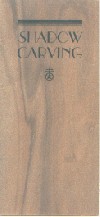


Individuals could commission Hall, through the Roycroft, to decoratively carve their own pieces for anywhere from $85.00 to $300.00. As their ad put it:
We will carve any sort of Old Wooden Box for you and make it into a Hope Chest, a Linen Chest, or a Treasure Chest, and we will do the work as well as we know how.... No copies but all in original designs.One story has it that Charles Hall and Bert Hubbard would scour the East Aurora streets on "trash day" to collect old 6-board chests, dressers, boxes, and other items that could be brought back to the Roycroft and carved into "objects d'art". A brochure, entitled Shadow Carving, was printed by the Roycroft and pictures several of these 6-board chests and chests-of-drawers.
The Shadow Carving brochure starts off with a very "romantic" preamble to the actual sale items shown inside. This initial text states:
He gave his God tangible form by making him out of a block of wood! His more civilized successor practiced this art of wood carving. Ancient Egypt, India and China have contributed to the treasury of wood sculpture and many examples of their work has been preserved.
Spain, France and Scandinavia have added their share and England's cathedrals and churches, stately mansions and castles are filled with the magnificent and priceless creations of craftsmen carvers in wood. The Roycrofters are in apostolic succession to these great artists.
Imbued with the same spirit that actuated their efforts Mr. Charles S. Hall and his helpers, work with head, hand and heart materializing dreams in terms of wood sculpture and wood decoration in an ivy-covered workshop at Roycroft. The result is a product that is arrestingly beautiful and desirable.
Brought under the magic of their dexterous tool-minded fingers antique wooden chests—old chairs or tables, oaken slabs and posts are made to reveal a story or record a theme. The chests pictured are antiques.
There are many other subjects and designs in the Roycroft collection—chests that have the tang of the sea—old sea chests bearing Spanish galleons—Viking chests with ships a-sail on a billowy sea—chests bearing woodland scenes and famous buildings—conventional designs and designs that meet the demand of the disciple of the nouveau art.
The Roycrofters will be happy to furnish you with estimates of the cost of similar work you may desire done. Cheerfully and carefully we will go over the proposition with you, whether it be a chest, a box, chair, table, or mantel, a sideboard, cabinet, plaque or reredos (a decorated screen). And we feel sure you will be delighted with our estimate and work. One such 6-board chest, in the brochure, shows a "before and after" carving where only the right half of a 6-board chest is carved. This includes a carved right half of the top, a carved right half of the front and a carved right end. The left side of the chest was left uncarved. The brochure says that this chest was in the process of transformation however as the carving is somewhat off-center I think that it was purposefully only half carved to show what could be done with a plain 6-board chest. The wood is pine approximately 3/4" thick and the left (uncarved) side of the front board has some serious cracks in it. These can be seen in the photo in the brochure from the 1930's and they are also present in the current piece (which can be seen in the next web page). Some of the carving is quite deep and extends into the wood within 1/16 of an inch from the backside of the board. On another page in the brochure are displayed several other 6-board chests, including the two from the Roycrofter magazine, each with a different design. Still more chests are pictured—some with very Byzantine looking designs. These small boxes and coffee tables were probably made for Charles Hall by the woodworkers at the Roycroft.
From time immemorial the decoration of wood has been a foremost art. Man has ever loved to "whittle." The aboriginal decorated his pipe-stem, his weapons and his paddle with grotesque figures of beasts and reptiles, fish and man or other objects symbolizing some emotion he felt.